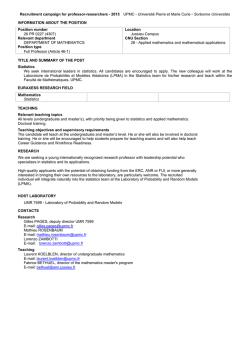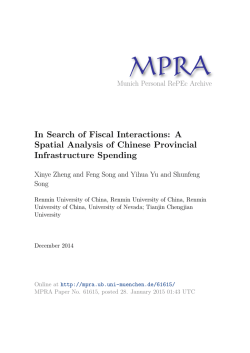
critical pedagogy of place in mathematics: texts, tools
CRITICAL PEDAGOGY OF PLACE IN MATHEMATICS: TEXTS, TOOLS, AND TALK Laurie Rubel, Vivian Lim1, Mary Candace Full2, Maren Hall-Wieckert1 1 City University of New York 2 University of California Los Angeles This paper explores the potential of integrating critical and place-based perspectives supported by mobile, digital technologies in secondary mathematics. The paper describes two curricular modules: Local Lotto, a mathematical investigation of the state lottery, and Cash City, a mathematical investigation about pawn shops, which were piloted in a high school in an underserved neighborhood in New York City. The analysis focuses on texts, tools, and talk (Philip & Garcia, 2013) introduced by a critical pedagogy of place in mathematics. INTRODUCTION Critical pedagogy of place (CPoP) in mathematics connects “the real world” and mathematics by integrating themes of critical mathematics education (Gutstein, 2005; Skovsmose, 1994) with an orientation of place (Gruenewald, 2003a, 2003b). Mathematics can be used to question, illuminate, elucidate, and communicate issues of power, fairness, and social justice, and such explorations can be considered in geoand socio-spatial terms. In other words, mathematics can be essential to understanding spatial justice by illuminating not only how a social phenomenon works but where it takes place, who participates and with what frequency, who is impacted, and if it is fair. Essential characteristics of urban spaces–their density and traversability by foot–make them especially conducive for CPoP. This paper explores the potential of CPoP with a specific focus on youth in high schools in underserved, urban neighborhoods in the United States. PERSPECTIVES Space and Place Notions of place and space are distinct but interrelated. A space becomes a place as an individual develops familiarity with it (Tuan, 1977). Place is not static and exists at multiple levels of scale, from the level of home as a place to the scale of a neighborhood as a place, which “acquires visibility through an effort of the mind” (Tuan, 1977, p .170). In this paper and in the project it describes, we take up high school students’ places/spaces at various levels of scale. Place in teaching and learning has been articulated in terms of place-based education (PBE, Gruenewald, 2003a, 2003b), with theoretical groundings in Dewey (1959). PBE is oriented around contextualizing learning in the learner’s physical environment. PBE is typically used in rural contexts, since rural spaces offer accessibility to environmental phenomena that can generate data productive for statistical investigations, mathematical modeling, and follow-up advocacy. Although “justice has a geography” (Soja, 2010) and despite the ubiquity of space in all that is social, critical pedagogy adopts historical and social perspectives and leaves spatial components unaddressed. For example, critical mathematics education (CME, Frankenstein, 1990; Gutstein, 2005; Skovsmose, 1994; Vithal, 2003) typically focuses on social or historical aspects of cultural activities in urban spaces, often without a lens on the spatial context in which those activities are practiced. CME supports students in developing critical and functional mathematical literacies (Apple, 1992 as cited by Gutstein, 2005); students use mathematics to challenge an oppressive status quo and, in so doing, learn more mathematics. CME could be extended to include spatial reasoning in functional and critical capacities. Critical spatial reasoning “challenges discriminatory geographies” (Soja, 2010), such as patterns in residential segregation or unequal distributions of resources across neighborhoods. Analogous to the way that CME often ignores issues of place and space, PBE typically ignores issues of diversity, race, social class and power. Integrating the two frameworks in a critical pedagogy of place (CPoP, Gruenewald 2003a, 2003b), specifically in mathematics, opens up possibilities for “reading and writing the world with mathematics” (Freire, 1998; Gutstein, 2005) with a spatial justice perspective. CPoP takes up critical and spatial perspectives, since “everything that is social (justice included) is simultaneously and inherently spatial, just as everything spatial, at least with regard to the human world, is simultaneously and inherently socialized” (Soja, 2010, p. 24). Mathematics, Technology, and CPoP School mathematics, with data literacy, quantitative reasoning, and mathematical modeling, is a natural disciplinary fit for analyzing “discriminatory geographies” (Soja, 2010) or spatial aspects of experience. Most students study geometry in high school, an entire course that is focused on space, but space is usually not contextualized and, if contextualized, it is rarely in terms relevant to youth’s places. Algebraic concepts of proportional reasoning or relationships between quantities link arguments about justice with geometric concepts like distance or area. For example, Brantlinger (2005) describes a “geometry of inequality” project in which high school geometry students compared the relative distribution of community spaces to liquor stores in South Los Angeles, relying on concepts of proportion and area to make arguments about spatial justice. New technologies support CPoP in mathematics and allow for the overlaying of representations of data on to representations of place and space. Mobile data gathering devices (c.f., Quintana, 2012; Trouche & Drijvers, 2010) or global positioning devices and mapping software that can readily represent geospatial data (c.f., Enyedy & Mukhopadhyay, 2007) make spatial perspectives especially conducive in urban school settings. The diversity of peoples and practices in a city, comingled with a high population density and associated geospatial patterns, provide a rich context to examine social phenomena in spatial contexts. A wide range of questions can be posed about a spatial arrangement; and geospatial technologies enable data gathering and representation of that data in spatial terms, relying on fundamental systems of geometric measurement, concepts of ratio and proportion, and mathematical representations. Learning environments and curriculum enabled by critical, spatial perspectives and supported by mobile and geospatial technologies have the potential to disrupt the notion of “classroom as container” (Leander, Phillips, & Headrick Taylor, 2010) by facilitating the integration of the world outside of school into students’ in-school learning. CPoP for Mathematics in Action: City Digits Learning Mathematics of the City in the City is a design and research project[1] to develop and study innovative “City Digits” resources for high school students’ learning of mathematics with a CPoP perspective. Four principles guide the development of a curricular arc and corresponding set of geospatial tools. The first principle is that mathematics is essential for understanding the phenomenon (how does it work?), beyond descriptive statistics or proportional reasoning. Second, the phenomenon must have a spatial (where does it occur?), quantitative component (how much/ how often?). Third, the phenomenon must also include subject and cultural dimensions (who is involved and how do they participate?). Finally, the fourth principle is that there must be potential to explore sociopolitical and social justice ramifications (who is impacted, who makes the decisions, and is it fair?). These design principles can be applied to a range of social themes or phenomena and can further guide the creation of new curriculum and spatial tools. City Digits has used these principles to design and study innovative curriculum and integrated digital tools that allow students to learn mathematics by investigating spatial perspectives of various phenomena. The design team selected the phenomena of lotteries and pawn shops as topics that readily correspond to the design principles. The first module, Local Lotto, focused on the state lottery in terms of how one plays, how likely it is to win, where in New York City people buy lottery tickets or win prizes, and with what relative frequency. The second module, Cash City, takes a similar spatial perspective and focuses on understanding how a pawn shop works in terms of the mathematics and practical considerations of a transaction, relative to borrowing money in other ways. The understanding of how a pawn shop loan works is set in the context of an analysis of the spatial distribution of mainstream and alternative financial institutions across New York City; where are banks, check cashers, pawn shops and wire transfer outlets located, what is the relative density of these categories of businesses, and what are relationships between these densities and other variables like population density, household poverty rates, density of new immigrants, or household income. Both curricular modules prompt questions about fairness, social justice, and space in that they can be viewed as systems that cater to, or prey on, the needs of people in low-income neighborhoods of a large metropolitan city. In the City Digits modules, students conduct field research with mobile technologies in their local streetscapes to gather quantitative and qualitative information. The mobile tools enable students to take photographs, conduct and gather audio interviews with citizens, and record data about locations of interest. The GPS functionality of the tools instantly publishes all of these types of media by location on a shareable map. Back in the classroom, or even at home, students can view their own and their peers’ findings to further contextualize their study of the phenomenon. By opening up opportunities for spatial analysis of a social phenomenon using mathematics, we invite youth to investigate the “geography of opportunity” (Jacobs, 1992) so to be able to “to take greater control over how the unjust spaces in which they live are socially produced” (Lefebvre, 1991 as cited by Soja, 2010, p.95). Neighborhoods must be aware of their own challenges so that they can defeat–and not be defeated by–them (Jacobs 1992). Since youth have unique insights into space and place, the City Digits tools allow youth to access spatial perspectives and to contribute their own voices and ideas about spatial justice. METHODS This study is grounded in design-based research methodology (Brown, 1992), comprised of iterative cycles of design, testing, and revision, in collaboration with classroom teachers, of two CPoP mathematics modules with associated technologies. Each cycle of the design-based research includes classroom implementation by classroom teachers in a high school in an underserved neighborhood in New York City. Findings from classroom implementation lead to new insights and questions, and this fuels additional iterations of cycle. We have undergone two iterations of this design-based research cycle with Local Lotto and with Cash City. Technology is often assumed to be a “quick fix” for schools in underserved neighborhoods, based on assumptions about student interest but can detract attention away from pedagogy and result in greater inequities (Philip & Garcia, 2013). In this paper, we analyze affordances of CPoP in mathematics enhanced with technologies according to Philip & Garcia’s (2013) notions of texts, tools, and talk. We examine technology in terms of the affordances it provides relative to pedagogy: how technology offers teachers, classrooms, and students new forms of text (sources and modes of information), tools (ways to interact with texts), and talk (means of communication). Our research question is: What text, tools, and talk does technology-infused CPoP introduce for mathematics teaching and learning? We draw on the following data sources: 1) design artifacts, including documentation of the curricular arc, individual lesson plans and their revisions, drafts of digital tools and their revisions, data and data representations used in the design of lessons and tools for Local Lotto and Cash City; and 2) data from two rounds of implementation of Local Lotto, including audio and field notes of classroom sessions and debrief sessions with teachers, video of student focus group interviews, and artifacts including student work. RESULTS Our analysis is organized according to the texts, tools, and talk prompted by technology-infused CPoP. We note a distinction between opportunities to reason about data at individual/local and aggregate/global scales, because students are typically adept at reasoning about data at the individual/local level of scale but extending reasoning to the aggregate/global scale is known to be challenging (BenZvi & Arcavi, 2001). In particular, our analysis demonstrates how the texts, tools, and talk prompted by CPoP in mathematics can bridge these levels of scale. Texts CPoP in mathematics compels new types of texts for teaching and learning, at multiple levels of scale. At the individual level of scale, students’ out-of-school knowledge and experiences are the cornerstone texts. Local Lotto and Cash City begin with students sharing what they know in a classroom word-wall activity organized to elicit and share students’ own daily, lived experiences to the given topic. This deliberate dedication to draw out students’ prior knowledge enables students to effectively “take up space” (Hand, 2014) at the classroom level with their ideas, experiences, and questions. The aggregated visual display of students’ ideas is a text that frames and guides the subsequent teaching and learning. To expand students’ understanding of a spatial theme beyond the individual level of scale, students use mobile technologies to collect novel types of text in the form of interviews with people in their neighborhoods, photographs of streetscapes, and other qualitative and quantitative data of interest. These texts help students to learn more about how the topic affects their neighbors and how it is spatially organized. Interviews with pedestrians and shopkeepers give students a sense of who and how many participate in the phenomena of the lottery and pawn shops as well as why they do so. Photographs of streetscapes shed light on the prevalence of the phenomenon in the local landscape in context. CPoP in mathematics emphasizes cartographic representations, or maps, that are the primary forms of texts that provide students information on the city by neighborhood scale. Local Lotto and Cash City present New York City choropleth maps by neighborhood to represent data and illustrate patterns across the city. For example, a Cash City map shows the relative availability of various financial institutions (Figure 1). The series of maps enable students to investigate relationships between relative densities of financial institutions and other variables, such as median household income or percentage of population born outside of the United States. Patterns in and across these relationships highlight issues of equity and justice. The Local Lotto and Cash City maps facilitate connections between texts at the local/individual and aggregate/global scales. For example, in Local Lotto, students can zoom in to view lottery sales and prize data at individual retail stores (Figure 2). Similarly, in Cash City, students gather data in field research and their findings are aggregated on a map, creating a micro-neighborhood scale representation of a spatial distribution. Figure 1: Map showing alternative financial institutions per bank (City Digits, 2014a) Figure 2: Map showing lottery net gains and loss per store (City Digits, 2014b) Tools Tools associated with CPoP offer students new ways to participate in learning. CPoP’s commitment to teaching students to understand the mathematics behind how local phenomena work invites the use of tools that aid toward reaching this goal. For example, in Local Lotto, students run trial simulations of various lottery games and then work together to create a physical tree diagram modeling all the possible outcomes of a small-scale lottery game. City Digits map tools enable students to use and remake an authorable map space (see Figure 3) as a text that works for them in understanding the organization of space where they live. Maps possess a traditional status as scientific/objective reproductions of reality but can be redefined as subjective examples of argumentation (Wood, 1992). City Digits map tools operate as a mediator between students’ local knowledge (“connaissance”) and the institutionalized knowledge (“savoir”) about their neighborhoods and enables one to speak back to the other as students both come to understand and then criticize geographic/social boundaries as artificially imposed by structures of power (Lefebvre, 1991). In this sense, the City Digits mapping tools work like crowd-sourced reviewer apps, with the end product being an authored environment populated by narrative accounts and reviews by local youth. The mapping tool allows students to toggle between their own authored map and larger city level maps. Figure 3: Text linkage: interview linked to map (City Digits, 2014c) Digital, authoring tools associated with CPoP offer opportunities for justification and reasoning with data. Students select and organize texts (i.e., “snapshots” of spatial representations, data points, interviews, classroom artifacts, etc.) to develop their own opinions and then substantiate and justify those opinions through a web-published, digital “tour.” The automated spatial tagging of data students gather situates local texts within a global representation, and the “tour” tool encourages students to synthesize their analyses from across local and global texts to form a coherent story. Talk New forms of mathematical communication are introduced through CPoP’s texts and tools among students and between students and the wider public. Data that students collect is aggregated online, and students’ digital tours are published on the web- based tool as well, allowing students to see each other’s work. The digital platform includes a comment feature for both student collected data and student created tours, further enabling students to communicate with each other or with teacher, in or out of school. On a broader scale, students talk to an authentic general audience through their web-published tours. In this way, the mathematical dialogue transcends the classroom both in terms of space and participants. Students have a new interface for creating a multi-scaled understanding of the phenomenon they are studying. CONCLUSIONS Critical pedagogy of place offers new forms of texts, tools, and talk that engage students in mathematical analyses that focus on a local phenomenon. These new modes of texts, tools, and talk span local and global scales; a critical, place-based study encourages defining and probing relationships between variables at local scales and detecting patterns at aggregate/global scales. This is especially important and promising for the teaching of mathematics in urban high schools. At a basic level, CPoP supports students in developing or improving functional mathematical literacies in terms of core concepts like ratio and proportion, area, percent, rate, or measures of central tendency. However, by using mathematics to pose and answer questions about spatial justice, CPoP also provides rigorous opportunities for students to develop critical mathematical literacies (Apple, 1992; Gutstein, 2005). Finally, by centering mathematical analyses of complex phenomena on students’ local environments, essential connections are forged between the in school learning and out of school knowledge and experiences. City Digits encourages students to “reinhabit” and “decolonize” their neighborhoods (Gruenewald, 2003b). City Digits encourages “decolonization” by revealing mathematically the inequities of the lottery or pawn shop systems and revealing spatially the distribution of these services across economic/social/geographic boundary-lines. Students come to understand not only the injustice of the astronomical chances of winning a state-promoted lottery or how a pawn-shop loan accrues interest but also how these systems specifically target low-income people in neighborhoods like their own. Using this knowledge informed by mathematics, students engage in “reinhabitation” through interaction with shop owners and exploration in their neighborhoods. These explorations lead students to develop a sense of how they are inhabitants of their neighborhood with a stake in the way in which it is organized as opposed to residents of their neighborhood who simply traverse it on their way to and from school (Orr, 1992 cited by Gruenewald, 2003b). Both “reinhabitation” and “decolonization” co-constitute the development of a mathematically informed critical perspective on place and the ways in which space is organized in everyday lives. NOTES 1. Learning Mathematics of the City in the City is supported by the National Science Foundation under Grant No. DRL-1222430 to the City University of New York. Any opinions, findings, and conclusions or recommendations expressed in this material are those of the authors and do not necessarily reflect the views of the National Science Foundation. This project is directed by Laurie Rubel and is conducted in collaboration with Sarah Williams from MIT’s Civic Data Design Lab and a interdisciplinary team of research assistants from CUNY and MIT. The Center of Urban Pedagogy participated in the design of the Local Lotto module. Teachers from the New York City Department of Education participated in design and implementation. REFERENCES Apple, M. W. (1992). Do the Standards go far enough? Power, policy, and practice in mathematics education. Journal for Research in Mathematics Education, 23, 412431. Ben-Zvi, D. & Arcavi, A. (2001). Junior high school students' construction of global views of data and data representations. Educational Studies in Mathematics, 45(1– 3), 35–65. Brantlinger, A. (2005). The geometry of inequality. In Gutstein, E., & Peterson, B. (Eds.) Rethinking mathematics: Teaching social justice by the numbers. Milwaukee, WI: Rethinking Schools. Brown, A. L. (1992). Design experiments: Theoretical and methodological challenges in creating complex interventions in classroom settings. Journal of the Learning Sciences, 2(2), 141-178. City Digits. (2014a). [Choropleth map of Alternative financial institutions per bank by neighborhood in New York City, 2014]. City Digits. Retrieved from http://citydigits.org City Digits. (2014b). [Map showing lottery net gains and loss by store in New York City, 2010]. City Digits. Retrieved from http://citydigits.org City Digits. (2014c). [User-uploaded data on choropleth map of median household income by neighborhood in New York City, 2010]. City Digits. Retrieved from http://citydigits.org Dewey, J. (1959). School and society. In M. Dworkin (Ed.), Dewey on Education (pp.76-78). New York, NY: Teachers College Press. Enyedy N. & Mukhopadhyay S. (2007) “They don’t show nothing I didn’t know”: Emergent tensions between culturally relevant pedagogy and mathematics pedagogy. Journal of the Learning Sciences, 16(2),139–174. Frankenstein, M. (1990). Incorporating race, gender, and class issues into a critical mathematics literacy curriculum. Journal of Negro Education, 59, 336-359. Freire, P. (1998). Teachers as cultural workers. Boulder, CO: Westview Press. Gruenewald, D. (2003a). Foundations of place: A multidisciplinary framework for place-conscious education. American Educational Research Journal, 40(3), 619654. Gruenewald, D. (2003b). The best of both worlds: A critical pedagogy of place. Educational Researcher, 32(4), 3–12. Gutstein, E. (2005). Reading and writing the world with mathematics: toward a pedagogy for social justice. New York: Routledge. Hand, V. (2014). “Taking up our space”: becoming competent learners in the mathematics classroom. In Nasir, N., Cabana, C., Shreve, B., Woodbury, E., Louie, N. (Eds.) Mathematics for equity: a framework for successful practice (pp. 91-106). New York: Teachers College Press. Jacobs, J. (1992). The Death and Life of Great American Cities. New York: Random House. (Original work published 1961). Leander, K. M., Phillips, N. C., & Taylor, K. H. (2010). The changing social spaces of learning: Mapping new mobilities. Review of Research in Education, 34(1), 329-394. Lefebvre, H. (1991). The production of space (Vol. 142). Blackwell: Oxford. (Original work published 1968). Orr, D. (1992). Ecological literacy. Albany: State University of New York Press. Philip, T. A. & Garcia, A. D. (2013). The importance of still teaching the iGeneration: New technologies and the centrality of pedagogy. Harvard Educational Review, 83(2), 300-319. Quintana, C. (2012). Pervasive science: Using mobile devices and the cloud to support science education anytime, anyplace. Interactions, 19(4), 76-80. Skovsmose, O. (1994). Towards a philosophy of critical mathematics education. Dordrecht: Kluwer Press. Soja, E. W. (2010). Seeking spatial justice (Vol. 16). U of Minnesota Press. Trouche, L., & Drijvers, P. (2010). Handheld technology for mathematics education: Flashback into the future. ZDM, 42(7), 667-681. Tuan, Y. F. (1977). Space and place: The perspective of experience. U of Minnesota Press. Vithal, R. (2003). In search of a pedagogy of conflict and dialogue for mathematics education. Dordrecht: Kluwer. Wood, D., & Fels, J. (1992). The power of maps. New York: Guilford Press.
© Copyright 2026



